牛津译林版八年级上Unit8集体备课教案
- 格式:doc
- 大小:131.50 KB
- 文档页数:16
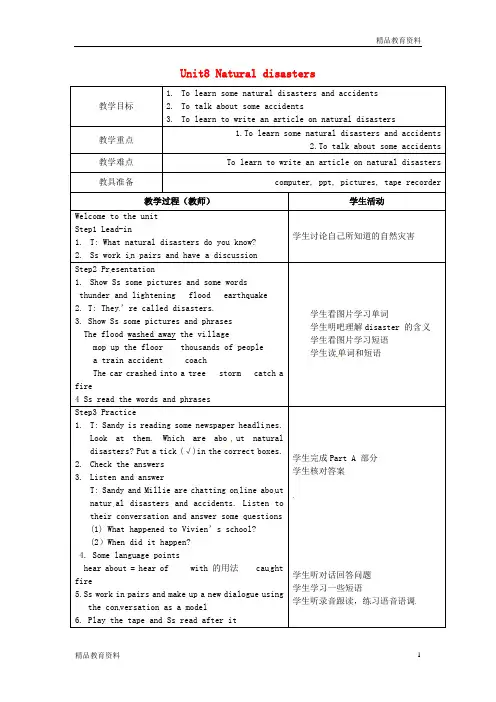
Unit8 Natural disasters教学目标1.To learn some natural disasters and accidents2.To talk about some accidents3.To learn to write an article on natural disasters教学重点1.To learn some natural disasters and accidents2.To talk about some accidents教学难点To learn to write an article on natural disasters 教具准备 computer, ppt, pictures, tape recorder 教学过程(教师)学生活动Welcome to the unitStep1 Lead-in1.T: What natural disasters do you know?2.Ss work i n pairs and have a discussion学生讨论自己所知道的自然灾害Step2 Pr esentation1.Show Ss some pictures and some wordsthunder and lightening flood earthquake2. T: They’re called disasters.3. Show Ss some pictures and phrasesThe flood washed away the vi llagemop up the floor thousands of peoplea train accident coachThe car crashed into a tree storm catch a fire4 Ss read the words and phrases 学生看图片学习单词学生明吧理解disaster 的含义学生看图片学习短语学生读单词和短语Step3 Practice1.T: Sandy is reading some newspaper headli nes.Look at them. Which are abo ut naturaldisasters? Put a tick (√)in the correct boxes.2.Check the answers3.Listen and answerT: Sandy and Millie are chatting on line abo ut natur al disasters and accidents. Listen to their conversation and answer some questions(1) What happened to Vivien’s school?(2)When did it happen?4. Some language pointshear about = hear of with 的用法 cau ght fire5.Ss work in pairs and make up a new dialogue usingthe con versation as a model6. Play the tape and Ss read after it 学生完成Part A 部分学生核对答案学生听对话回答问题学生学习一些短语学生听录音跟读,练习语音语调Comic stripStep1 Presentation1.Listen to the conversation and answer questions(1)What’s the weather like?(2)What happened to Ho bo?(3)What was Hobo doing when it started to rain?(4)Did Hobo hear the rain?(5)Why doesn’t he want to go home alone?(6)What do you think of Hobo?2.Some language pointswake up 醒来wake sb. up 叫醒某人mop up 拖干,把......拖干fall from 从……掉下,落下学生听对话回答问题学生学习相关语言点Step 2 Practice1.Act the comic strip out2. Finish some exercises on the ppt 学生表演对话学生完成ppt上的相关练习Step3 Homework1.Write an article about the natural disaster2.Review the words and phrases and some languagepoints3. Preview reading教学反思。
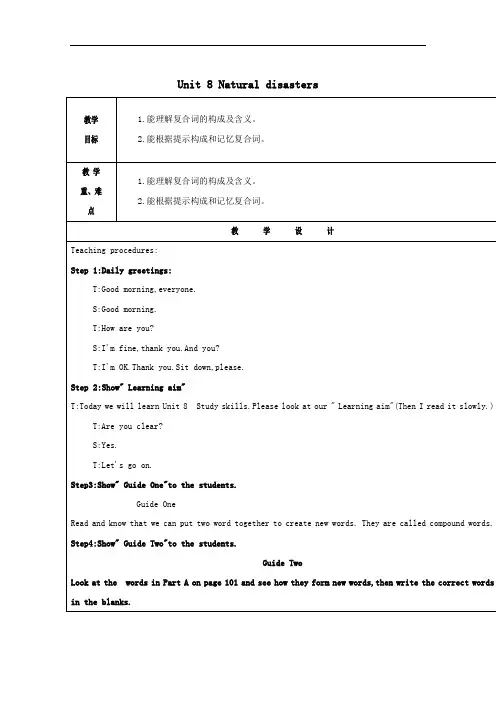
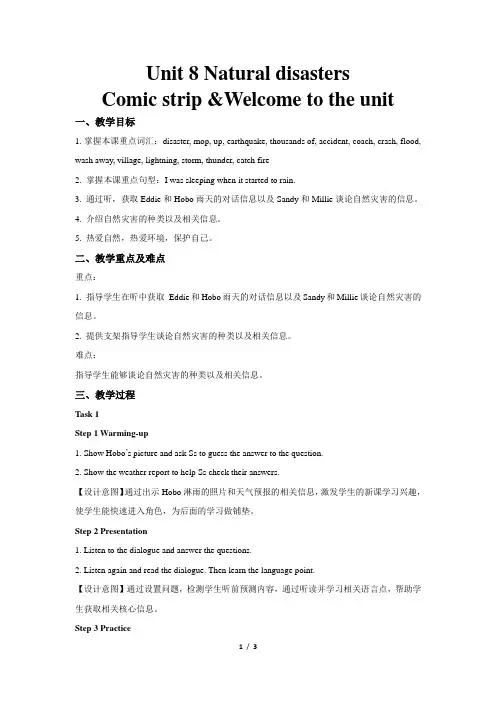
Unit 8 Natural disastersComic strip &Welcome to the unit一、教学目标1.掌握本课重点词汇:disaster, mop, up, earthquake, thousands of, accident, coach, crash, flood, wash away, village, lightning, storm, thunder, catch fire2. 掌握本课重点句型:I was sleeping when it started to rain.3. 通过听,获取Eddie和Hobo雨天的对话信息以及Sandy和Millie谈论自然灾害的信息。
4. 介绍自然灾害的种类以及相关信息。
5. 热爱自然,热爱环境,保护自己。
二、教学重点及难点重点:1. 指导学生在听中获取Eddie和Hobo雨天的对话信息以及Sandy和Millie谈论自然灾害的信息。
2. 提供支架指导学生谈论自然灾害的种类以及相关信息。
难点:指导学生能够谈论自然灾害的种类以及相关信息。
三、教学过程Task 1Step 1 Warming-up1. Show Hobo’s picture and ask Ss to guess the answer to the question.2. Show the weather report to help Ss check their answers.【设计意图】通过出示Hobo淋雨的照片和天气预报的相关信息,激发学生的新课学习兴趣,使学生能快速进入角色,为后面的学习做铺垫。
Step 2 Presentation1. Listen to the dialogue and answer the questions.2. Listen again and read the dialogue. Then learn the language point.【设计意图】通过设置问题,检测学生听前预测内容,通过听读并学习相关语言点,帮助学生获取相关核心信息。
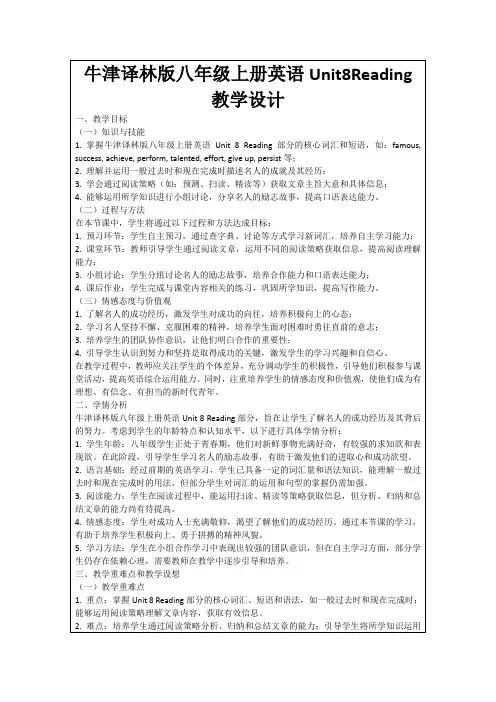
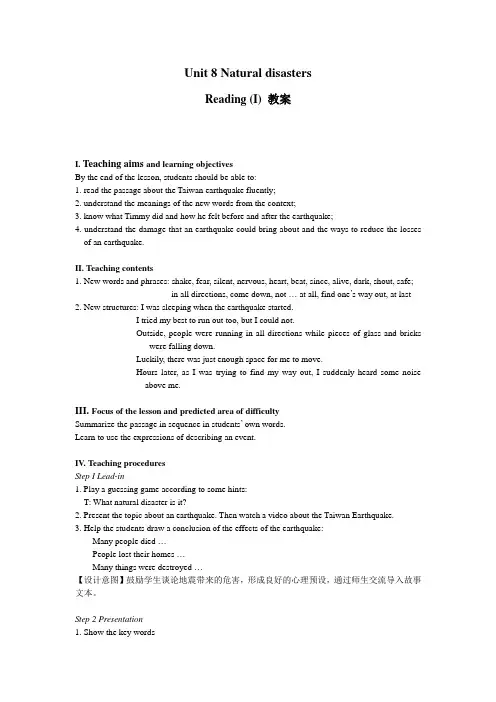
Unit 8 Natural disastersReading (I) 教案I. Teaching aims and learning objectivesBy the end of the lesson, students should be able to:1. read the passage about the Taiwan earthquake fluently;2. understand the meanings of the new words from the context;3. know what Timmy did and how he felt before and after the earthquake;4. understand the damage that an earthquake could bring about and the ways to reduce the losses of an earthquake.II. Teaching contents1. New words and phrases: shake, fear, silent, nervous, heart, beat, since, alive, dark, shout, safe;in all directions, come down, not … at all, find one’s way out, at last2. New structures: I was sleeping when the earthquake started.I tried my best to run out too, but I could not.Outside, people were running in all directions while pieces of glass and bricks were falling down.Luckily, there was just enough space for me to move.Hours later, as I was trying to find my way out, I suddenly heard some noiseabove me.III. Focus of the lesson and predicted area of difficultySummarize the passage in sequence in students’ own words.Learn to use the expressions of describing an event.IV. Teaching proceduresStep I Lead-in1. Play a guessing game according to some hints:T: What natural disaster is it?2. Present the topic about an earthquake. Then watch a video about the Taiwan Earthquake.3. Help the students draw a conclusion of the effects of the earthquake:Many people died …People lost their homes …Many things were destroyed …【设计意图】鼓励学生谈论地震带来的危害,形成良好的心理预设,通过师生交流导入故事文本。
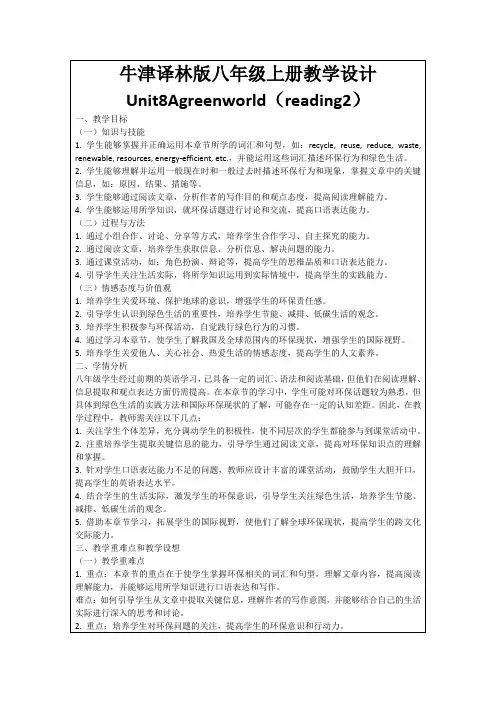
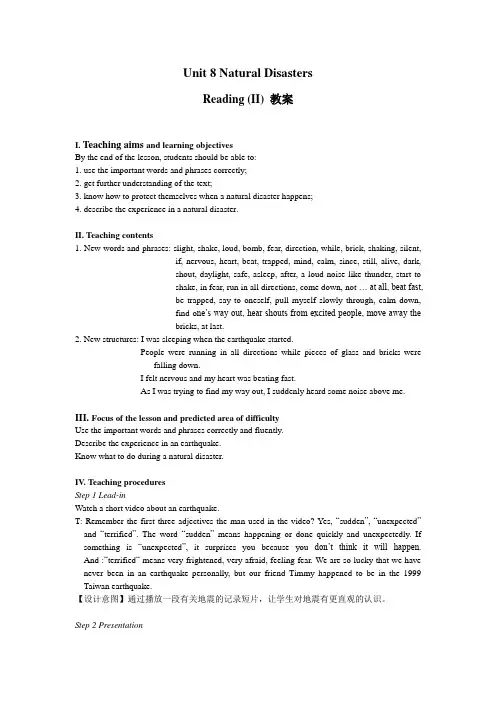
Unit 8 Natural DisastersReading (II) 教案I. Teaching aims and learning objectivesBy the end of the lesson, students should be able to:1. use the important words and phrases correctly;2. get further understanding of the text;3. know how to protect themselves when a natural disaster happens;4. describe the experience in a natural disaster.II. Teaching contents1. New words and phrases: slight, shake, loud, bomb, fear, direction, while, brick, shaking, silent,if, nervous, heart, beat, trapped, mind, calm, since, still, alive, dark,shout, daylight, safe, asleep, after, a loud noise like thunder, start toshake, in fear, run in all directions, come down, not … at all, beat fast,be trapped, say to oneself, pull myself slowly through, calm down,find o ne‟s way out, hear shouts from excited people, move away thebricks, at last.2. New structures: I was sleeping when the earthquake started.People were running in all directions while pieces of glass and bricks were falling down.I felt nervous and my heart was beating fast.As I was trying to find my way out, I suddenly heard some noise above me. III. Focus of the lesson and predicted area of difficultyUse the important words and phrases correctly and fluently.Describe the experience in an earthquake.Know what to do during a natural disaster.IV. Teaching proceduresStep 1 Lead-inWatch a short video about an earthquake.T: Remember the first three adjectives the man used in the video? Yes, “sudden”, “unexpected”and “terrified”. The word “sudden”means happening or done quickly and unexpectedly. If something is “unexpected”, it surprises you because you don‟t think it will happen. And :“terrified“ means very frightened, very afraid, feeling fear. We are so lucky that we have never been in an earthquake personally, but our friend Timmy happened to be in the 1999 Taiwan earthquake.【设计意图】通过播放一段有关地震的记录短片,让学生对地震有更直观的认识。
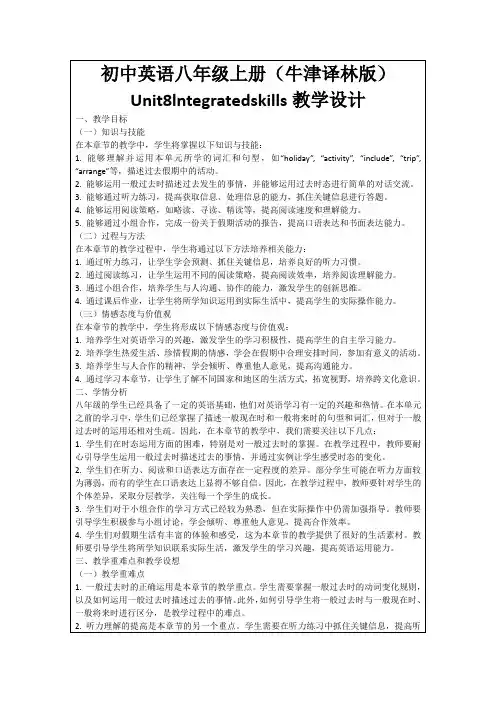
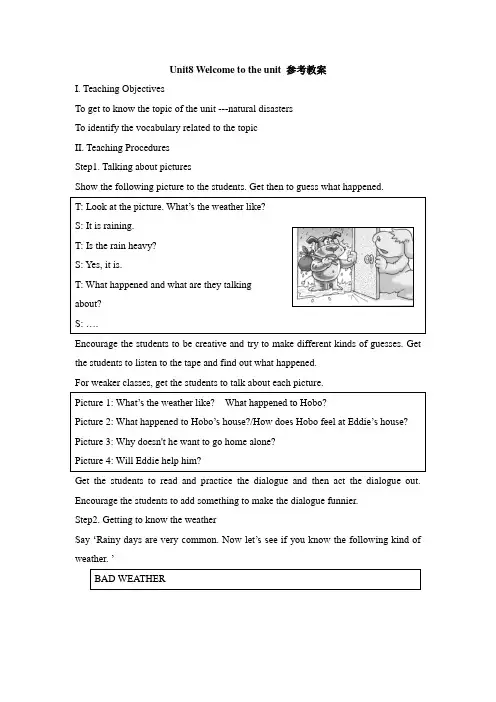
Unit8 Welcome to the unit 参考教案I. Teaching ObjectivesTo get to know the topic of the unit ---natural disastersTo identify the vocabulary related to the topicII. Teaching ProceduresStep1. Talking about picturesShow the following picture to the students. Get then to guess what happened.Encourage the students to be creative and try to make different kinds of guesses. Get the students to listen to the tape and find out what happened.For weaker classes, get the students to talk about each picture.Get the students to read and practice the dialogue and then act the dialogue out. Encourage the students to add something to make the dialogue funnier.Step2. Getting to know the weatherSay ‘Rainy day s are very common. Now let’s see if you know the following kind of weather. ’For stronger classes, it is necessary to introduce more bad weather, like storm and sandstorm etc.Put it clear that bad weather sometimes can cause disasters (Teach the word ‘disaster’ and explain it in English ‘A natural disaster is a very bad accident caused by natural forces. It usually causes great damage or loss of life.’)Show pictures about the disasters and elicit the disasters, like flood, drought, tsunami, and hurricane, and earthquake etc.Step3. Making a summary about bad weather and disastersStep4. Finishing the exercises in Part AGet the students to finish the exercises in Part A and then check the answers.。
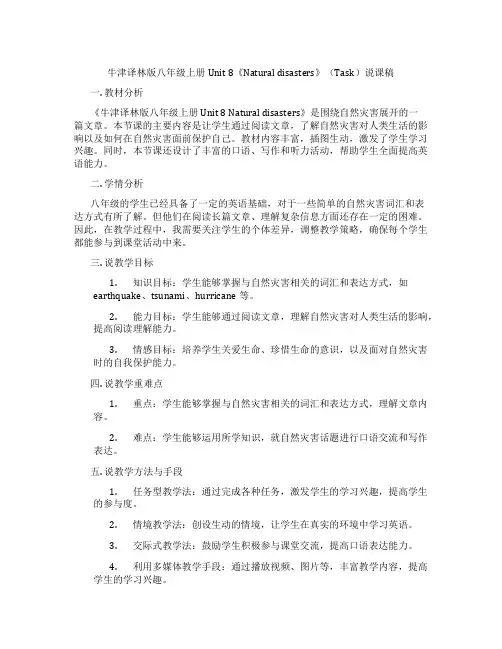
牛津译林版八年级上册Unit 8《Natural disasters》(Task)说课稿一. 教材分析《牛津译林版八年级上册Unit 8 Natural disasters》是围绕自然灾害展开的一篇文章。
本节课的主要内容是让学生通过阅读文章,了解自然灾害对人类生活的影响以及如何在自然灾害面前保护自己。
教材内容丰富,插图生动,激发了学生学习兴趣。
同时,本节课还设计了丰富的口语、写作和听力活动,帮助学生全面提高英语能力。
二. 学情分析八年级的学生已经具备了一定的英语基础,对于一些简单的自然灾害词汇和表达方式有所了解。
但他们在阅读长篇文章、理解复杂信息方面还存在一定的困难。
因此,在教学过程中,我需要关注学生的个体差异,调整教学策略,确保每个学生都能参与到课堂活动中来。
三. 说教学目标1.知识目标:学生能够掌握与自然灾害相关的词汇和表达方式,如earthquake、tsunami、hurricane等。
2.能力目标:学生能够通过阅读文章,理解自然灾害对人类生活的影响,提高阅读理解能力。
3.情感目标:培养学生关爱生命、珍惜生命的意识,以及面对自然灾害时的自我保护能力。
四. 说教学重难点1.重点:学生能够掌握与自然灾害相关的词汇和表达方式,理解文章内容。
2.难点:学生能够运用所学知识,就自然灾害话题进行口语交流和写作表达。
五. 说教学方法与手段1.任务型教学法:通过完成各种任务,激发学生的学习兴趣,提高学生的参与度。
2.情境教学法:创设生动的情境,让学生在真实的环境中学习英语。
3.交际式教学法:鼓励学生积极参与课堂交流,提高口语表达能力。
4.利用多媒体教学手段:通过播放视频、图片等,丰富教学内容,提高学生的学习兴趣。
六. 说教学过程1.导入:以一段关于自然灾害的视频导入,激发学生的学习兴趣。
2.阅读理解:学生阅读文章,回答相关问题,了解自然灾害对人类生活的影响。
3.词汇学习:学生通过小组合作,归纳总结文章中出现的自然灾害词汇。
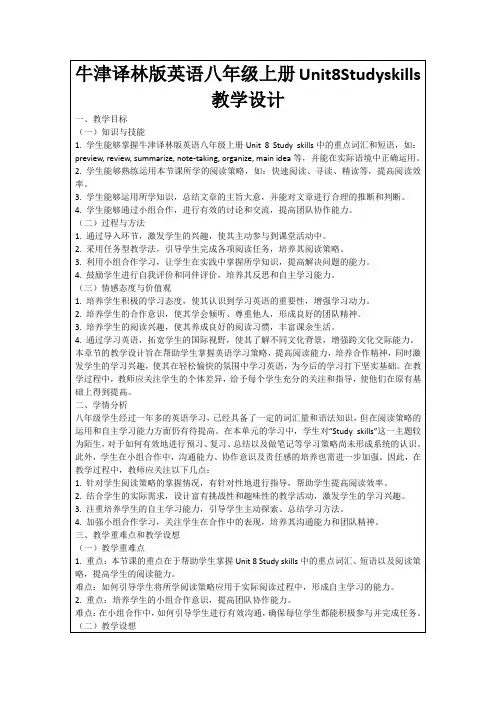
《Unit 8 Natural disasters Integrated skills》Teaching aims and demands:News words: condition, cover, caller, victim, arrival, mobile phone, serious,Phrases and sentences:the 110 receive a call from sbcrash into a treeweather conditionscover the whole roadnumber of victimsconditions of vi ctimstime of arrivalhurt her left leg9 arrive at Sunshine Hospital at 7.55 p.m.10 the snow was really heavy by then.11 call 110 using his mobile phone12 in the snowstorm13 it was not very serious14 There was a heavy storm with thunder and lighting.15 Her school caught fire because lighting hit it.16 Was she hurt?Teaching methods: task-based approachTeaching task:Learn some telephone numbers.Teaching aids: tape recorder, tapes, slide projector, slidesTeaching procedures:Task 1 Free talk.Ask the students to have a weather report in class.Task 2 Say something about the picture.Show some pictures to the students and let the students say something about the picture.Task 3 Fill in the blanks with 110 120 119 114 1211.A:“Look out ,there is a fire !” B: “Don’t worry about it. Let’s call____ hotline.2.A: “That boy fell from a tree and hurt badly.” B: “Don’t move him. Let’s call ____hotline.3.If a car crashed into a tree, we will call___ hotline.4.A: “ Today is so cold!What about tomorrow’s weather?B: “Sorry, I don’t know. You can see the weather forecast or you can call___ hotline.5.A: “I want to call Jim, but I don’t know his number.”Task 4 Listen.Task 5 Fill in the form.Accident: Their car crashed into(1)_________.They are(2)________in the car.Weather conditions: There is(3)___________and it covers the whole place.Date of call: (4)___________________Time of call: (5)___________________Name of caller: (6)__________________Place: (7)__________________No. of victims: (8)_______Conditions of victims: Mr. Su—(9)______________________________Mrs. Su----(10)____________________________Action: Policemen arrived at(11)________Sent the victims to(12)________________ at(13)____________Police ReportDate of call 28th JanuaryTime of call 7.40 p.m.Time of arrival 7.45 p.m.Place Starlight Street, Sunshine TownNo. of victims TwoConditions of victimsAction Arrived at Sunshine Hospital at 7.55 p.m.Accident: Their car crashed into(1)_________.They are(2)________i n the car.Weather conditions: There is(3)___________and it covers the whole place.Da te of call: (4)___________________Time of call: (5)___________________Name of caller: (6)__________________Place: (7)__________________No. of victims: (8)_______Conditions of victims: Mr. Su—(9)______________________________Mrs.Su----(10)____________________________Action: Policemen arrived at(11)________Sent the victims to(12)________________ at(13)____________Dear VivienHow are you? I left school early yesterday because the snowstorm started again in the afternoon and it got worse later. The snow was really heavy by then.This morning I read a newspaper article about a car accident. A man named _____ called 110 at_____ using his mobile phone. His car crashed into______ while he was driving in___________ . He and his wife were ______ in the car. The snow was _______ and it covered everything. The policemen arrived at _______ and they sent them to hospital at ______ Mr. Su felt ______and __________but he was not hurt. Mrs. Su hurt her _________but it was not very serious. Now, I know that bad weather can be dangerousWhat about London? Do you have snowstorms there? Please e-mail me soonSandyTask 6 Retell the accidentAsk the students to retell the accident without looking at their books.Task 7 Make a dialogueTASK:Please make a report on your paper, when th ey act.Then let’s share your report.Task 8 Listen to the tape, What happened in Britain?2. What caused the fire?3. Was anyone hurt? Then answer the questions:Task 9 Read the dialogue and make up new dialogueS1: Did you hear about…?S2: No. What happened?S1:… There was…S2: Oh, really?S1:Yes, it was terrible. …S2:….Task 10 Underline the useful phrasesthe 110 receive a call from sbcrash into a treeweather conditionscover the whole ro adnumber of victimsconditions of vi ctimstime of arrivalhurt her left leg9 arrive at Sunshine Hospital at 7.55 p.m.10 the snow was really heavy by then.11 call 110 using his mobile phone12 in the snowstorm13 it was not very serious14 There was a heavy storm with thunder and lighting.15 Her school caught fire because lighting hit it.16 Was she hurt?Task 11 Exercise in class.1.You _________(lose) your key inside just now, so how can you find it inside?2. The twins _____________(work) on the machine when you ______(come) in.3.They ______________(plant) 10,000 trees in 1995.4. Our knowledge of the universe __________( grow) all the time.5. No one know s what__________ (happen) in 100 years.6. Our maths teacher always tells us never ____________(lose) heart when we are in trouble. Homework1. Revise what we have learnt today.2. Copy all the phrases.3. Finish the exercise on your workbook.。
Unit 8 Natural disastersWritten by wanggongbingPre-reading Task 1 Lead in:1.Have a free talk about the earthquake2. Present new words and expressionsWhile-reading Task 2 General reading1 ScanningRead and answer the questions1.Did he survive at last?2.Did he find his way out(come out)by himself?2 SkimmingHelp Sandy to complete the passage.Timmy is a teenager:He lives in Taiwan.He survived the 1 in 1999.He was sleeping when he heard a loud noise.It was like the noise of 2 .Then the noise became really loud.It sounded like 3 under the ground.After that,pieces of glass and 4 fell down.When the noise ended,he was 5 and could not get out.A moment of 6 went through his mind.Then he tried to 7 down and 8 for help.Finally,people moved away the bricks and stones and saved him.While-reading Task 3Detailed reading1.Para 1-2 Fill in the formWhen the earthquake came,what did Timmy feel/hear/see/do? He…2.Para 3-5 Read and answerWhat did Timmy do to save himself after he was trapped?3.Further thinking Read with feelings●At first,I felt a slight shake.●“I’m trapped.”●I shouted for help,but no one came.●I screamed,“Help!Please help!I’m here!”Sentence understandingWhat’s the meaning of…?At last,I saw the bright daylight.Post-reading Task4 practice1.Do Part B22.Discuss ways of protectingAfter the earthquake,Timmy has some useful ways of protecting himself in the earthquake.If you are Timmy,what good ways of protecting yourself do you know?Post-readingTask 5Write a reportI saw an article about the earthquake.when the earthquake happened______________________________________________ ______________________________________________________________________________ ______________________________________________________________________________ ______________________________________________________________________________ ______________________________________________________________________________ If I was Timmy,I should___________________________________________________ ______________________________________________________________________________ ______________________________________________________________________________ Homework1.Remember the new words in this lesson.2.Read aloud the article and try to retell the story.。
课题8A Unit 8 Welcome to this unit 课型New教学目标1. To learn the common names of natural disasters.2. To help students to know different kinds of weather and disasters.3. To arouse the students’ interest in natural disasters.教学重点To learn the common names of natural disasters.教学难点I was sleeping when it started to rain.教学过程教师内容备课札记Step1.Talking about the picture.(Show a picture with rainy weather)1.Get students to talk about what happens in the picture.For example:What’s t he weather like? How is the weather? Is therain heavy?2.Review the words about the weather.Step2.Presentation.1)Introduction:Hobo has some trouble. What has happened to him?Let’s have a look .2)Students read comic strip.What’s the weather like?What happened to Hobo?What was bob doing when it started to rain?When did Hobohear the rain?What happened to Hobo’s house?Why doesn’t he want to go home?4)Repeat the dialogue after the tape.5)Have difficulties to explain.Be all wet全湿了Mop all the water up用拖把把所有的水拖掉I was sleeping when it started to rain.当开始下雨的时候我正在睡觉。
Step3.Getting to know the weatherIntroduction:Rainy days and fine days are very common, (ask students:What other kind of weather do they know?2.Discussion.3.Check(Students can say it in Chinese).At the same time ,teach the new words about the weather.Typhoon, thunder,lightning, rainstorm snowstorm4.Bad weather sometimes cause disasters.Teach:disaster and we call them natural disasters.5.Ask students to talk about weather and disasters.Heavy rain and rainstorm----------flood1.Thunder and lightning---------fireStep4.Finish the exercises in Part A.Do and check the answersStep5.Discussing about the bad weather and disaster.What will happen if there is a …?How will you feel if there is a...?What will you do if there is a…?Step 6 Homework1. Read the text book and learn the new words and phrases by heart.2. Discuss with your friend how to protect our Earth.板书设计教学反思课题8A Unit 8 Reading (1) 课型New教学目标1. To guess general meanings from keywords and context2. To skim text for overall meanings and scan for details教学重点1.To value students’ ability of reading2.To educate students to be careful with disasters like fire .教学难点To develop the ability to infer the general meaning from title and context.教学过程教师内容备课札记Step1.Revision1) Introduction:We learnt something about natural disaster last time.What disaster have we learnt?2) Students discuss in pairs.Step2.Presentation.Use students’ answer to discuss an earthquake.For example:Where does it usually happen?How do people feel when it happens?Step3.Read the passage about “The Taiwan Earthquake”pay attention to the following questions:When the earthquake happened, What was I doing?Why did people scream?Did the writer survive?Stpe4.Presentation.1.Read the passage themselves.2.Repeat after the tape.3.Have difficulties to explain.4.be trapped=be in trouble陷入困5.at first=at the beginning 在开始6.a loud noise like thunder像雷声一样的声音7.in fear恐惧be frightened害怕8.in all directions四面八方run wildly拼命地跑9.try one’s best to do sth=do one’s best to do sth尽力做某事10.pieces of glass玻璃片calm down冷静下来11.be over,结束12.say to oneself自言自语13.shout for help喊救命14.move away搬15.look at each other in fear恐惧地对看着16.do some shopping买东西17.stay alive活着18.go through my mind闪过头脑Sentences:I was doing my homework when it started.I didn’t know if anyone was around me.I didn’t know where I was.Some people screamed because they were very frightened.People were running wildly while pieces of glass and bricks were falling down.They didn’t know where to go.Some people ran out of the shopping centre.I thought somebody could hear me but no one came for a long time.I was trying to find my way out when I suddenly heared some noise above me.Step5.Consolidation.1).Read the passage again.2).Give students some key words, and ask them to retell the story if time permitted.Step6 Homework1. Read the text correctly and fluently.2. Do the exercises.3. Retell the passage.板书设计教学反思课题8A Unit 8 Reading 2 课型New教学目标1. To get more detailed information about the earthquake in Taiwan2. To analyze the sentences for the students to get a better understanding.3. To make sure the students know how to protect themselves during the earthquake.教学重点To get more detailed information about the earthquake in Taiwan教学难点To analyze the sentences for the students to get a better understanding.教学过程教师内容备课札记Step1.Review the new words.Repeat after the teacherStep2.Review the phrases.(Ask some students to come the blackboard to have a dictation orask students to translate according to the Chinese.)Step3.Review the text.(According to the following questions)1.What was I doing when the earthquke started?2.At first, how did I feel?3.Then what did I hear?4.Why did some people scream?5.What did the real noise like?6.How did people run?7.Did they know where to go?8.What did I try to do?9.While pieces of glass and bricks were falling down, what werepeople doing?10.What about the walls?11.Did the writer believe the earthquake was over when the noiseand shaking ended?12.Could the writer see anything around him?13.Did I know where I was?14.At last, was I safe?Step4.Listen and repeatStep5. Go through Part B & CStep 6 Homework1.Read and retell Reading.2.Remember words, phrases and sentences.plete the exercises on books.4. Preview Grammar. and get ready for dictation板书设计教学反思课题8A Unit 8 Grammar 课型New 教学目标To understand when to use the past continuous tense.教学重点To recognize and use the past continuous tense教学难点To recognize and use the past continuous tense教学过程教师内容备课札记Step 1 QuestioningSay, ‘Now, I am teaching you. You are listening to me carefully.’(ask A)What are you doing?(ask B)What did A do just now?(ask B)What were you doing when A answered my question?(ask C)What were you doing when I came in?(ask A)What was C doing at that time?(ask D)What were you doing while I was talking with A,B,C?Step 2 Design a sceneAs the students are talking about the things they do, write thestructure of past continuous tense ‘was/were +doing’ on the board.Step 3 Paying attention to uses of wordsDuring the students describing the pictures, pay attention to use‘was’ and ‘were’ to consolidate the past continuous tense.Step 4 Describing the pictureDescribe the picture in general questions and give them positiveand negative answers. Practice in pairs. Write the two kinds ofanswers on the Bb.Was David cooking at eight yesterday? Yes, he was.Was David having dinner at 8 last night? No, he wasn’t.Step 5 Practicing the dialogueAfter finishing describing the nine pictures, practice the dialoguelike this.T: What was David doing last night at eight last night?Ss: He was doing some cooking.Practice in pairs. Let them choose any picture they want.Step 6 Completing Part A1Get the students to complete Part A1, Page 99. Check the answers in pairs and in class. Explain the main phrases in the dialogue e.g. ‘discuss … with…’ and ‘plan a trip to’. Get them to read the dialogue aloud.Ask the students some question to offer them more chance for practice.Step 7 Finishing the dialogueFinish the dialogue in Part A2, and then check the answers. Explain some the main phrases like ‘see…doing’ and ‘as usual’. Ask the students to close the book. Ask them some questions about this dialogue.Step 8 Homework1.Review Grammar.2.Remember words,phrases and sentences.plete the exercise on book.4. Preview Integrated skills.板书设计教学反思课题8A Unit 8 Integrated Skills 课型New教学目标To get specific information from a listening materialTo understand the process of producing an accident report formTo recognize the key expressions involved in an emergency call and an accident report教学重点To understand the process of producing an accident report form教学难点To recognize the key expressions involved in an emergency call and an accident report教学过程教师内容备课札记Step 1 Talking about the weatherFirst, get the students to talk about the weather today.(This is an activity that can be organized throughout the whole text).Step 2 Showing a picture of snowy daysShow a picture of snowy days and then get the students to talk about the weather condition. Encourage the students to discuss what will happen to cars and people.Step 3 Discussing about what the victims can doThey can shout for help. They can use their mobile phone to call the 110 hotline. They can also call the 120 hotline for help. Motivate to think about what information should be involved in the call. What happen?(the accident)Weather conditionName of the callerStep 4 Looking at the two reports on Page 102Explain that Mr. and Mrs. Su had a car accident during the snowstorm. Ask students to look at the two reports on Page 102 and explain that the report form in Part A1 is from the 110 hotline where as the report in Part A2 is made by the policemen after they rescued Mr. and Mrs. Su.Explain the items in the report form and make sure that they canunderstand it.Step 5 Playing the tape two timesPlay the tape two times for the students to find as muchinformation as possible. And then fill in the report form. And ofcourse, it is impossible for them to complete the table by listening.Get them to read the repot below and find more information.(One thing to mention here is that the teacher can also get studentsto understand how the victims through their voice. If possible, getthem to imitate it. )Step 6 Calling the police for helpDivide the students into two groups. Suppose that they are indifferent situations and encourage them to call the police for help.Step 7 Homework1.Remember the words, phrases and sentences.2.Recite Part B.plete the exercises on book.4.Preview Study skills.板书设计教学反思课题8A Unit 8 Study Skills课型New教学目标To find the main points of a passage in order to understand and memorize it more easily.To identify keywords in order to develop general understanding of a passage.To guess meaning and generate mental pictures.教学重点To describe an disaster or an accident by responding to questions and interacting with others教学难点To describe an disaster or an accident by responding to questions and interacting with others教学过程教师内容备课札记Step 1 Talking about picturesShow pictures of different kinds of bad weather and disasters. Get the students to talk about the results of them. They can also talk about what other people do to help.(It will be better if the teacher can collect some reports on disasters or bad weather from newspapers or magazines. In this step, the teacher may try to input more information about the disasters and help students to talk about it.)Step 2 Listen to the tapeExplain that Sandy and Amy are talking about a natural disaster. Invite them to listen to the tape and try to answer the questions. With the help of these questions, it will be easier for students to focus on the key information e.g. in Britain, last week, heavy storm, thunder and lightening, terrible, school caught fire, no one was hurt, students on holiday. They will also help them to organize their own dialogue.Step 3 Reading the dialogue againGet the students to read the dialogue aloud. Direct the students attention to the intonation of different sentences. We use a rising tone for general questions. We use falling tones for ‘wh-’ questions or statements. Get the students to read the dialogue again. Pay special attention to the intonation patterns used here. Then give thestudents several minutes for the students to practice and act.Step 4 Talking about a disasterGet them to talk about a disaster. They can choose what the would like and try to make a new dialogue.Offer them enough time to practice and then get them to act their own dialogue out in front of the class.Step 5 Homework1.Remember some important words, phrases and sentences.plete the exercises on books.3. Preview Task.板书设计教学反思课题8A Unit 8 Task 课型Revision教学目标To plan ideas for writingTo learn the proper and easy ways to write something;教学重点To write a description of the disasters教学难点To generate personal ideas, plan and organize text to express one's own opinions教学过程教师内容备课札记Step 1 Talking about picturesShow a picture of a snowstorm and get the students to talk about it.Step 2 Writing an article about a natural disasterExplain that Sandy wants to write an article about a naturaldisaster. Write the following sentences on the board beforehandwith blanks.Get the students to fill in the blanks. In this ways, they can getsome idea about what sandy saw, what she heard and how she felt.Get the students to read the sentences one by one. Motivate thestudents to read it aloud.Step 3 Making a flow chartTell the students that Sandy also makes a flow chart to organize herideas. Divide the students into groups of 4. Invite the students tohelp Sandy complete the flow chart. Then ask them to discuss theanswers in groups of 4. Check the answers.Direct students’ attention to the way that the flow chart wasorganized. Point out that introduction gives us some facts.Then Sandy is going to talk about the things that happened duringthe snowstorm and then after the storm.Sandy tells us what she saw, what she hear and how she felt duringand after the snowstorm.After this it is important to point out that to organize the ideas willhelp people who are telling a personal story. It is also veryimportant for the speaker to consider of the audience.Step 4 Completing the sample articleGive the students 4-5 minute to complete the sample article. And then check the answers to it.Get the students to figure out the structure of the article.Step 5 Locating some important sentence patternsGo through the article and help the students to locate some important sentence patterns.I looked out of the window and saw that people were working hard to remove the snow.Step 6 Homework1.Remember the words, phrases and sentences.2.Read and recite sample writing.3.Write a passage about your ideal school.板书设计教学反思课题8A Unit 8 Self-assessment 课型Revision教学目标To review what they have learnt in this unitTo revise the use of past continuous tenseTo identify the vocabulary about bad weather and natural disasters教学重点To revise the use of past continuous tense教学难点To identify the vocabulary about bad weather and natural disasters教学过程教师内容备课札记Step 1 Giving a weather reportGet a student give a weather report. Then get them to talk abouttheir favorite weather.Step 2 Eliciting the use of past continuous tenseRemind the students of the to pic of this unit ‘Natural Disaster’.Elicit the use of past continuous tense. By asking somequestions.What was Timmy doing when the earthquake happened?He was doing some shopping when the earthquake happened.While/ when he was doing some shopping the earthquake.While / he was doing some shopping, his mother was cooking athome.Explain the way past continuous tense is used and when to use‘when’ or ‘while’.Step 3 Finishing off the exercises in Part AGet the students to finish off the exercises in Part A,Page107. Get the students to check the answers in pairs and thencheck them in class. Do this orally and write the most importantwords on board. When we come to some familiar topics here, wecan talk more about it. For stronger classes, it is good to talkabout more natural disasters.Step4 Do some more consolidate exercises Step5 Homework1.Review the whole unit2. Complete exercises板书设计教学反思。